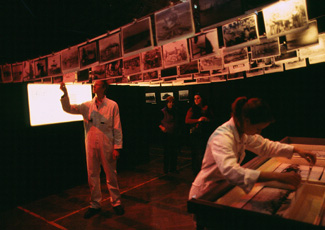History loosed from its moorings
Kay Schaffer

Andrew Brackman & Alison Gordon, The Memory Museum
photo David Wilson
Andrew Brackman & Alison Gordon, The Memory Museum
The Adelaide-based Memory Museum is one of the more ambitious, if sadly ephemeral, events to be celebrated for the Centenary of Federation. Appropriately staged in the old Drill Hall of the Torrens Parade Ground, the installation works the theme of war through the metaphor of memory excavation. The Memory Museum stages a dramatic, visually and aurally challenging, emotionally provocative experience; a polyglot of the different voices of South Australia. Visitors begin their labyrinthine journey in near-darkness on an archaeological site where excavators call out names of war dead retrieved from the ruins of Western civilisation for a Roll of Honour. From there we journey through 13 chambers in 9 rooms, each connected to different historical moments recalling Australia’s engagements with war.
In 9 sites, students from the Flinders University Drama Centre enact short performances or monologues to conjure up memories of people and events associated with the war. Under the tutelage of drama professor Julie Holledge, students devised segments of the performance and sometimes scripted the monologues in the year leading up to the exhibition. Research included the conduct of personal interviews with members of veteran associations as well as Indigenous, women’s and refugee groups, in addition to working with archival material from national, state and private collections. As in good postcolonial practice, students do not occupy the spaces of those remembered; rather they become the retrievers and curators of memory, piecing together fragments from interviews, letters, postcards and photographs to construct versions of stories that are then exchanged and passed on. Droll stories like the one that ‘takes the piss’ out of British General Birdwood standing semi-naked in the Aussie heat, or resourceful stories like those of WRAN prisoners of war fashioning outfits from worn-out sailor’s pants, colourfully designed with lipstick features.
There are 2 exceptions to the student-as-curator-of-memory rule. One is the poignant performance of Peter Michell, who effectively embodies the memory of his grandfather, a man he never met (he died in the war) but whose censored letters home provide the springboard to memory. Through recovering gaps in the letters Michell relives 5 wartime events, from incidences of hookworm to a horrendous bombing which resulted in shrapnel wounds to his grandfather’s ankle, rump, and arm, and the loss of his right eye. Standing on an excavation site that doubles as a bunker, set against a backdrop of walls papered with hundreds of letters home, Michell renders the horrors of war through the loving voice of the laconic Anzac soldier: “Don’t worry love, I’m really fine…You can hardly notice.”
The other notable exception is the performance of Vietnamese-born, Australian-raised war orphan, Dominic Golding. Dominic was rescued from Saigon through the auspices of the World Vision Orphanage, initiated in the 1970s by a now-prominent South Australian psychotherapist, Rosemary Taylor. Sitting cross-legged on the ground in army fatigues, Dominic relates his reminiscences to a camcorder in a halting, speech impaired voice. Two massive screens behind him pick up his face, superimposed upon images that fill in the gaps of his stories. Ironies abound, like how he constructed his “Vietnamese” identity through American post-war movies; or suffered discrimination while growing up in Mount Gambier, not so much as a result of his ethnicity but because of his deafness; and how he realised his nostalgia for the “old” Saigon through doctored videos taken in 1999 during his first trip “home.”
Mary Moore conceived the complex, interactive staging for the exhibition around effective and economic geographies of colour, light, sound and space. A womb-like space occupies the core of the labyrinth, where colours of the student curators’ uniforms change from stark black and white to pink, and where the lighting lifts from the grey shades of outdoor battlefield ruins to the warm, flesh-toned interiors of kitchen, lounge, laundry and sewing room. At the centre, 2 female curators ‘pick’ at the fragments of garments obtained from women’s prison camps. An overstuffed armchair, a cast iron stove and a sewing machine punctuate the walls of the detention camp, suggesting an interpenetration of public and private spheres, a co-mingling of the war at home and abroad. Nora Heysen’s lively portraits and official photographs of WRAN nurses line the walls of the outer circle. Voices of survivors and crackling newsreel tapes echo round the space, telling of the fall of Singapore and the capture, detention and death of hundreds of nurses at the hands of the Japanese. Outside the circle, the war at home is remembered through a wall plastered with features from Women’s Weekly and life-sized blowups of the Anzac Arch and “Cheer Up” clubs that once occupied the banks of the Torrens where the Festival Centre now stands.
As groups mingle in the spaces, boundaries between official military history and personal reminiscence, archive and memory, past and present, performance and recollection, performer and visitor break down. Carrying a postcard with them on which they are invited to record their own memory of war, visitors exit from the white glare of the final “treaty” room to a desk, a computer display and an Australia Post mail bag. Off to the side, a student curator sorts the postcards, registering through her silent gestures the gamut of emotions they provoke. The journey loops back to our beginnings and spirals beyond, loosening history from its moorings to live on/in us.
Memory Museum, commisioned by Centenary of Federation SA, producers Adelaide Festival Trust, Flinder University, Creative Director Mary Moore, Installation Director Tim Maddock, Drill Hall, Torrens Parade Ground, Adelaide, Oct 21- Nov 4
RealTime issue #46 Dec-Jan 2001 pg. 37






